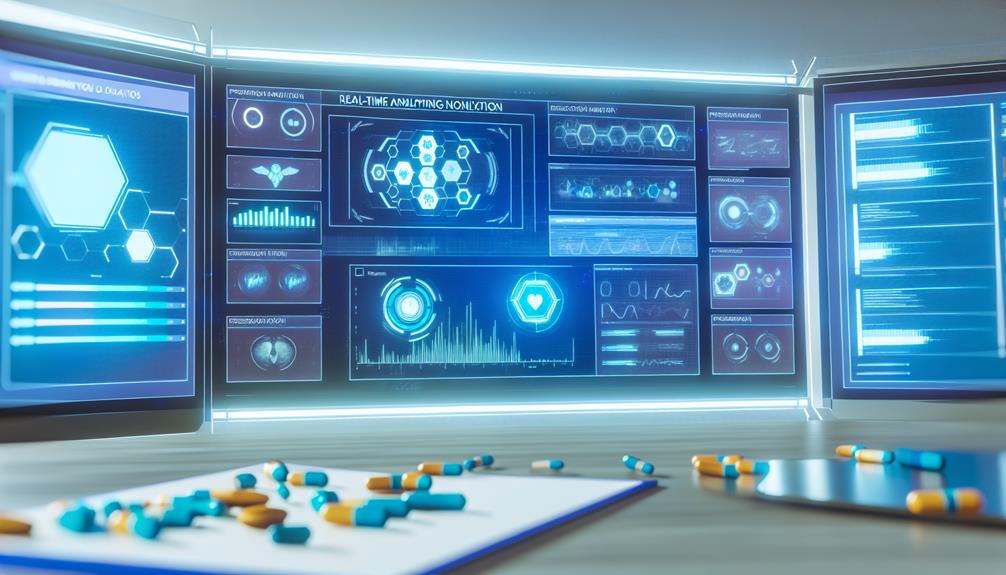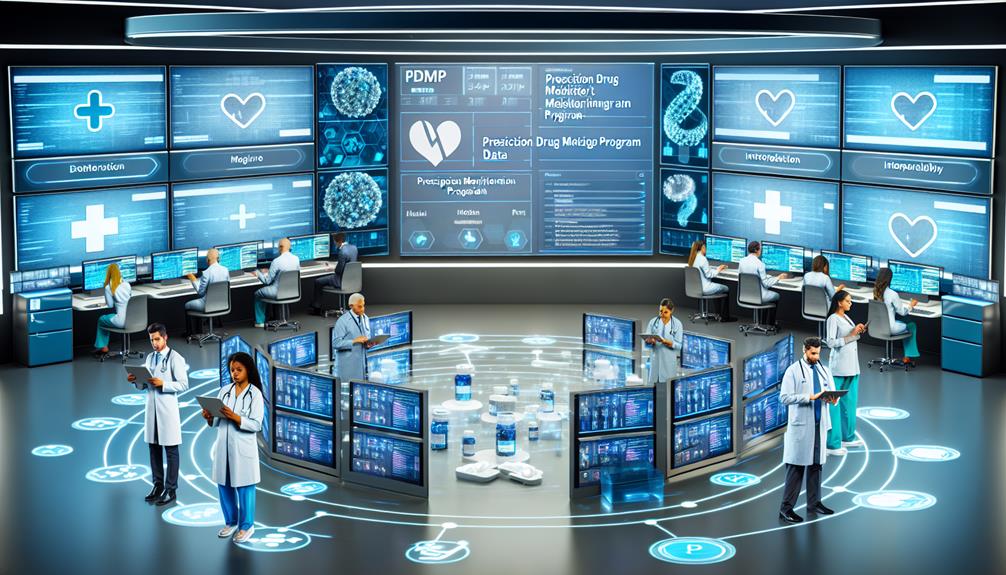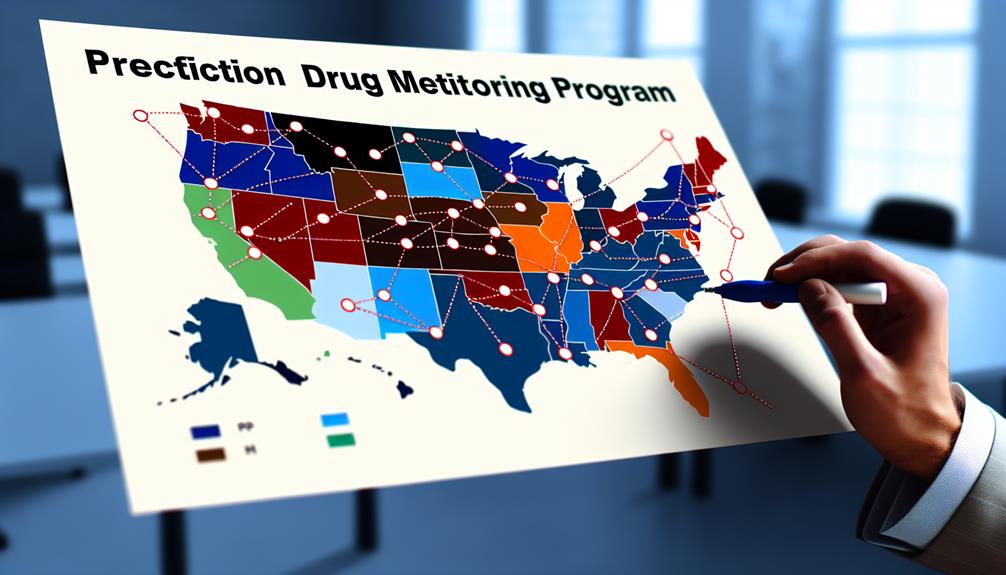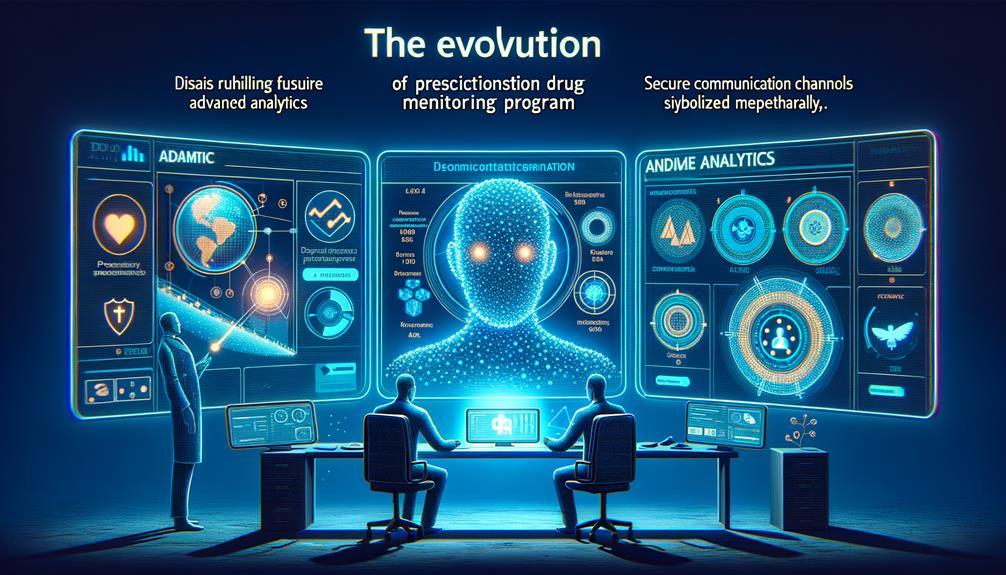Are you tired of outdated and inefficient prescription drug monitoring programs? Look no further, as we present to you the 9 best innovations that are revolutionizing the way we monitor and manage prescription drugs.
From real-time data analytics to collaboration among states, these advancements are paving the way for a more efficient and effective system.
But that's not all, there's something even more intriguing about these innovations that will leave you wanting to discover more.
Real-Time Data Analytics

Real-time data analytics play a crucial role in enhancing the effectiveness of prescription drug monitoring programs by providing immediate insights into the utilization patterns and potential risks associated with controlled substances. These programs rely on the collection and analysis of vast amounts of data to identify patterns and trends in prescription drug use.
However, ensuring data privacy and security is of utmost importance to protect sensitive patient information.
To address these concerns, prescription drug monitoring programs implement robust data privacy and security measures. This includes the use of encryption techniques to safeguard data during transmission and storage. Access to the data is strictly controlled, with only authorized personnel having the necessary permissions. Regular audits and monitoring are conducted to detect any unauthorized access or breaches.
Additionally, anonymization techniques are employed to remove personally identifiable information from the data, further safeguarding patient privacy. This allows for the analysis of aggregated data without compromising individual patient confidentiality.
Furthermore, prescription drug monitoring programs work closely with law enforcement agencies and other stakeholders to ensure the secure exchange of data. Collaboration and information sharing are facilitated through secure communication channels, protecting the integrity and confidentiality of the data.
Artificial Intelligence Integration
Prescription drug monitoring programs have embraced the integration of artificial intelligence (AI), leveraging its capabilities to further enhance data analysis and improve the effectiveness of monitoring controlled substances. AI technology advancements have opened up new possibilities for these programs, allowing for more accurate identification of potential misuse and abuse of prescription drugs.
Here are some key artificial intelligence applications in prescription drug monitoring programs:
- Pattern recognition: AI algorithms can identify patterns in prescription drug data, such as frequent doctor shopping or multiple prescriptions from different pharmacies, which may indicate potential abuse or diversion of controlled substances.
- Predictive modeling: By analyzing large sets of historical prescription data, AI can predict trends and patterns that may indicate the likelihood of future misuse or abuse. This allows for proactive interventions and targeted monitoring efforts.
- Natural language processing: AI-powered systems can analyze unstructured data, such as doctor's notes or patient comments, to extract relevant information and identify potential red flags.
The integration of artificial intelligence into prescription drug monitoring programs holds immense potential for improving the identification and prevention of prescription drug misuse and abuse. With ongoing advancements in AI technology, these programs can continue to evolve and become even more effective in safeguarding public health and safety.
Predictive Risk Scoring

Predictive risk scoring in prescription drug monitoring programs involves the use of advanced algorithms to predict and identify potential risks early on. These algorithms analyze data such as patient information, prescription history, and medical records to generate risk scores that indicate the likelihood of misuse or abuse of prescription drugs.
Advanced Algorithms for Prediction
Using sophisticated algorithms, healthcare professionals can now accurately predict the risk of adverse events associated with prescription drug use. Advanced data visualization techniques enable these algorithms to process vast amounts of patient data, providing valuable insights into potential risks.
Machine learning applications analyze patterns and trends within the data, allowing healthcare professionals to identify patients who may be at a higher risk for adverse drug events. This predictive risk scoring approach helps prioritize interventions and interventions, reducing the likelihood of harm.
The advanced algorithms take into account various factors such as patient demographics, medical history, and medication usage. By leveraging these algorithms, healthcare professionals can make informed decisions and provide personalized care to mitigate the risks associated with prescription drug use.
Early Identification of Risks
Healthcare professionals can leverage the advanced algorithms and data visualization techniques discussed previously to identify potential risks associated with prescription drug use.
Early identification of risks is crucial for effective early intervention and risk assessment. By analyzing data from prescription drug monitoring programs (PDMPs), healthcare professionals can identify patterns and trends that may indicate potential risks for patients. These risks can include excessive medication use, potential drug interactions, or signs of addiction.
Through predictive risk scoring, healthcare professionals can assign a risk score to each patient based on their prescription drug use history. This allows for targeted interventions and proactive measures to be implemented, such as adjusting medication dosages, providing counseling or support services, or considering alternative treatment options.
Enhanced Patient Monitoring
Enhanced patient monitoring in prescription drug monitoring programs involves the use of real-time data tracking and remote patient monitoring.
Real-time data tracking allows healthcare providers to monitor a patient's prescription drug use in real-time, enabling them to identify any potential issues or risks.
Remote patient monitoring allows patients to be monitored outside of traditional healthcare settings, providing healthcare professionals with valuable insights into a patient's medication adherence and overall health status.
These innovative approaches enhance patient safety and enable proactive intervention when necessary.
Real-Time Data Tracking
Real-time data tracking facilitates enhanced patient monitoring within prescription drug monitoring programs. This technology allows for the continuous monitoring of patients' prescription drug usage, providing healthcare providers with up-to-date information on their patients' medication adherence and potential misuse. With real-time data visualization, healthcare professionals can easily identify patterns and trends in patients' prescription drug usage, enabling them to intervene and provide appropriate care when necessary.
Key Features of Real-Time Data Tracking:
- Real-time data visualization: Allows healthcare providers to view patients' prescription drug usage in real-time, providing a clear and comprehensive overview of their medication history.
- Data security: Ensures that patients' sensitive information is protected and only accessible to authorized individuals, safeguarding their privacy and complying with data protection regulations.
- Privacy: Maintains patients' confidentiality by securely storing and transmitting their prescription drug data, protecting their personal health information from unauthorized access or disclosure.
Real-time data tracking in prescription drug monitoring programs plays a crucial role in improving patient safety, optimizing treatment plans, and preventing prescription drug misuse.
Remote Patient Monitoring
Remote patient monitoring revolutionizes patient care by allowing healthcare providers to track and analyze patients' health data from a distance, facilitating proactive interventions and personalized treatment plans. This innovative approach combines telehealth integration and patient engagement to enhance the overall quality of care.
Through remote patient monitoring, healthcare providers can remotely monitor patients' vital signs, symptoms, and medication adherence, enabling them to detect any changes or potential issues in real-time. By collecting and analyzing this data, healthcare providers can make informed decisions and intervene promptly, leading to timely adjustments in treatment plans and improved patient outcomes.
Furthermore, remote patient monitoring promotes patient engagement by empowering individuals to actively participate in their own care. Patients can access their health data, receive educational resources, and communicate with their healthcare providers, fostering a collaborative and patient-centered approach to healthcare delivery.
Interoperability With Healthcare Systems

To achieve seamless integration between prescription drug monitoring programs (PDMPs) and healthcare systems, developers are working on enhancing interoperability through standardized data exchange protocols. This interoperability is crucial for improving patient care, reducing prescription drug abuse, and ensuring effective coordination among healthcare providers.
Key considerations for interoperability with healthcare systems include:
- Data privacy: With the exchange of sensitive patient information between PDMPs and healthcare systems, data privacy becomes a paramount concern. Developers are implementing robust security measures, such as encryption and access controls, to protect patient data from unauthorized access or breaches.
- Legal implications: Interoperability between PDMPs and healthcare systems raises legal considerations, including compliance with federal and state laws regarding patient privacy and consent. Developers are working closely with legal experts to ensure that the exchange of prescription drug data adheres to all applicable regulations.
- Integration challenges: Integrating PDMPs with existing healthcare systems can be complex due to variations in data formats and systems architecture. Developers are devising strategies to overcome these challenges, such as employing data mapping techniques and utilizing interoperability standards like HL7 (Health Level Seven) to facilitate seamless data exchange between systems.
Efforts to enhance interoperability between PDMPs and healthcare systems aim to improve patient safety, streamline care coordination, and enable healthcare providers to make more informed decisions regarding prescription drug use.
Prescription Alerts and Notifications
Prescription alerts and notifications play a crucial role in providing timely and vital information to healthcare providers about potential risks and considerations related to patients' prescription drug use. These alerts and notifications are designed to enhance patient safety and improve prescriber education by delivering real-time information regarding drug interactions, allergies, and potential adverse effects.
One key aspect to consider when implementing prescription alerts and notifications is patient privacy. Healthcare providers must ensure that the system used to deliver these alerts and notifications is secure and compliant with privacy regulations. Patient information should be protected and only accessible to authorized individuals involved in the patient's care. Additionally, the system should have safeguards in place to prevent unauthorized access or disclosure of sensitive patient data.
Prescriber education is another essential component of the prescription alerts and notifications system. Healthcare providers must be properly trained on how to interpret and respond to these alerts and notifications. They should understand the potential risks associated with certain drug combinations or patient characteristics and be able to make informed decisions based on the information provided. Regular updates and ongoing training sessions should be conducted to ensure healthcare providers stay up-to-date with the latest developments in prescription drug monitoring.
Electronic Prescribing and Controlled Substance Tracking
Electronic prescribing and controlled substance tracking have revolutionized the way healthcare providers manage and monitor the prescription and dispensing of controlled substances. This innovative approach to medication management offers several benefits, including increased efficiency, improved patient safety, and reduced prescription drug abuse.
Efficiency: Electronic prescribing eliminates the need for handwritten prescriptions and manual data entry, streamlining the prescription process. Providers can quickly and accurately send prescriptions directly to pharmacies, saving time for both patients and healthcare professionals.
Patient Safety: Electronic prescribing systems help prevent medication errors by providing real-time drug interaction alerts and allergy checks. This ensures that patients receive appropriate medications and reduces the risk of adverse drug events.
Reduced Prescription Drug Abuse: Controlled substance tracking through electronic systems allows healthcare providers to monitor and track the dispensing of these medications. This helps identify potential cases of prescription drug abuse, diversion, or doctor shopping, allowing for early intervention and prevention.
While electronic prescribing and controlled substance tracking offer numerous advantages, there are also challenges to consider. One significant challenge is ensuring patient privacy and data security. Safeguarding patient information is crucial to maintain trust and comply with privacy regulations. Healthcare providers must implement robust security measures to protect sensitive patient data and prevent unauthorized access.
Integration With Pharmacy Management Systems
Integration with pharmacy management systems enables seamless coordination between healthcare providers and pharmacies, enhancing medication management and improving patient care. Pharmacy integration refers to the connectivity and interoperability between electronic health record (EHR) systems used by healthcare providers and pharmacy management systems used by pharmacies. This integration allows for real-time sharing of prescription information, including medication orders, dispensing records, and patient medication histories.
By integrating pharmacy management systems with healthcare providers' EHR systems, healthcare professionals can have a comprehensive view of patients' medication profiles. This helps to identify any potential drug interactions, allergies, or duplications, ensuring safer and more effective medication management. Additionally, it allows healthcare providers to monitor patients' medication adherence, helping to address non-compliance issues and improve overall patient outcomes.
Pharmacy integration also streamlines the prescription filling process. When a prescription is electronically transmitted from the healthcare provider's EHR system to the pharmacy management system, it eliminates the need for manual data entry, reducing the risk of errors and increasing efficiency. Pharmacists can access the prescription information directly from the pharmacy management system, enabling them to dispense medications accurately and promptly.
Collaboration and Data Sharing Among States

To enhance the effectiveness and efficiency of prescription drug monitoring programs, states are increasingly collaborating and sharing data with each other. This collaboration and data sharing among states is crucial in combating the abuse and diversion of prescription drugs. Here are some key ways in which states are working together:
- Interstate Data Sharing Agreements: States are entering into agreements that allow them to share prescription drug monitoring program data with each other. These agreements enable healthcare providers to access patient information across state lines, helping them make informed decisions about prescribing controlled substances.
- Data Standardization: States are working together to develop common data standards for prescription drug monitoring programs. This ensures that data can be easily shared and accessed by healthcare providers, regardless of which state they're in. Standardization also allows for more accurate analysis and reporting of prescription drug data on a national level.
- Collaborative Analytics and Research: States are collaborating on data analytics and research initiatives to identify trends, patterns, and best practices in prescription drug monitoring. By pooling their resources and expertise, states can better understand the impact of prescription drug abuse and develop strategies to address it effectively.








